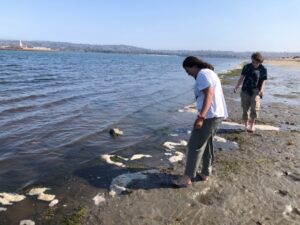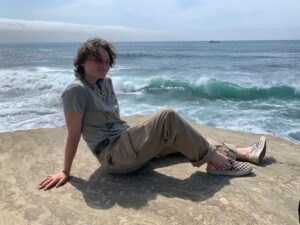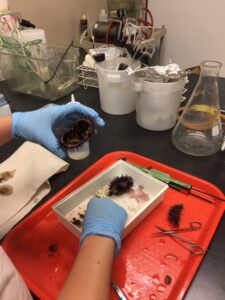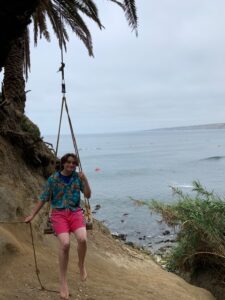Didi EarthTree, Marine Biology at CMIL, Week 2
Hello, my name is Didi and my internship is at the CMIL Marine Biology lab. I am working with lobsters and microorganisms. At the lab, we are studying the feeding patterns of the lobsters along with counting and identifying microorganisms in eelgrass. This lab is in San Diego, California, along the ocean shore. This week I helped with new research on Asian Mussels and the beginning of a lobster experiment.
 At the beginning of the week, Lulu and I went to Fiesta Island to assist a scientist look for an invasive species of mussels. The Asian Mussels multiply so quickly that with every step you can feel their shells sticking out of the mud. This, however, made it easy for us to collect, and by the end, we had almost 400 mussels. The following day, I worked in the field with several interns and people who were assisting a scientist with her experiment. In the experiment, we were observing which of two spots accommodated and housed mussels the best over a two-week period. The scientist testing this experiment was going to be doing a study on a larger scale later, but for now, she was deciding the location of the experiment by placing mussels in each of the two areas. After building six cages for them from chicken wire, they were placed over a cluster of 50 mussels to ensure no predators like lobsters or crabs could prey on them. The mussels that we were working with are an invasive species and multiply so quickly that you can run across them at almost every muddy beach in the San Diego area.
At the beginning of the week, Lulu and I went to Fiesta Island to assist a scientist look for an invasive species of mussels. The Asian Mussels multiply so quickly that with every step you can feel their shells sticking out of the mud. This, however, made it easy for us to collect, and by the end, we had almost 400 mussels. The following day, I worked in the field with several interns and people who were assisting a scientist with her experiment. In the experiment, we were observing which of two spots accommodated and housed mussels the best over a two-week period. The scientist testing this experiment was going to be doing a study on a larger scale later, but for now, she was deciding the location of the experiment by placing mussels in each of the two areas. After building six cages for them from chicken wire, they were placed over a cluster of 50 mussels to ensure no predators like lobsters or crabs could prey on them. The mussels that we were working with are an invasive species and multiply so quickly that you can run across them at almost every muddy beach in the San Diego area.
The majority of my day on Wednesday was spent sorting the many types and species of microorganisms that were living in eelgrass. This is done by finding tiny pods of dirt that the organisms have made a home out of, and breaking it open. Then you can retrieve them and put them in the sorted pile. Looking through a large folder of the microorganism species, you see which one to categorize it under. The length of the antenna and body can usually help you in identifying them. Being able to categorize them is what makes you feel accomplished in this task.
On Thursday and Friday, I helped Vanessa set up several lobster experiments. She is running experiments to see how many urchins lobsters can eat. The previous thought was that lobsters would be the main predator after the sea otters left. This however may not be the case. All of the studies in process are showing that lobsters in fact do not eat many urchins and that they are not even their first choice of food. The experiments that Vanessa will be running are going further in-depth with the process and amount that lobsters are eating the urchins.
 In the time after going to the internship, Lulu, Jadin, and I went to the county fair and went on several rides there. Both Jadin and I had never been on a Ferris Wheel ride before so that was quite entertaining. After this, we went to the beach and realized we had made a grave mistake when we all three stepped in front of a wave and got tumbled back onto the shore. The rest of the time we had fun trying to dive through the waves, and swim with the strong current. At a previous beach, the only way to get up was through a series of ladders and ropes that led to a swing. We cautiously took turns swinging on it before heading to the fair.
In the time after going to the internship, Lulu, Jadin, and I went to the county fair and went on several rides there. Both Jadin and I had never been on a Ferris Wheel ride before so that was quite entertaining. After this, we went to the beach and realized we had made a grave mistake when we all three stepped in front of a wave and got tumbled back onto the shore. The rest of the time we had fun trying to dive through the waves, and swim with the strong current. At a previous beach, the only way to get up was through a series of ladders and ropes that led to a swing. We cautiously took turns swinging on it before heading to the fair.
Overall, the week was very busy but I learned a lot, and can not wait till next week when I can help with more lobster experiments.



There are no comments published yet.